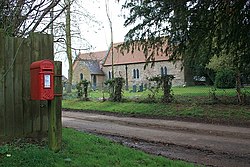Difference between revisions of "Ullingswick"
(Created page with "{{Infobox town |name=Ullingswick |county=Herefordshire |picture=Postbox, Ullingswick - geograph.org.uk - 1199231.jpg |picture caption= |os grid ref=SO596499 |latitude=52.14624...") |
|||
| Line 9: | Line 9: | ||
|population= | |population= | ||
|census year= | |census year= | ||
| − | |post town= | + | |post town=Hereford |
| − | |postcode= | + | |postcode=HR1 |
|dialling code= | |dialling code= | ||
| − | |LG district= | + | |LG district=Herefordshire |
|constituency= | |constituency= | ||
}} | }} | ||
| − | '''Ullingswick''' is a small village in [[Herefordshire]], about six miles south-west of [[Bromyard]], nine miles north-east of [[Hereford]] and ten miles south-east of [[Leominster]]. The population of the village at the 2011 census was 259. | + | '''Ullingswick''' is a small village and ancient parish in [[Herefordshire]], about six miles south-west of [[Bromyard]], nine miles north-east of [[Hereford]] and ten miles south-east of [[Leominster]]. It forms part of the hundred of [[Broxash]]. The population of the village at the 2011 census was 259. |
The village is listed in the [[Domesday Book]] of 1086 as ''Ullingwic''. The name is apparently the Old English ''Ullinga wic'', meaning "Ulla's family's village". | The village is listed in the [[Domesday Book]] of 1086 as ''Ullingwic''. The name is apparently the Old English ''Ullinga wic'', meaning "Ulla's family's village". | ||
| − | The village church, St Luke's, dates from the 13th century in a Gothic | + | The village church, St Luke's, dates from the 13th century in a Gothic style. It was however extensively restored in 1863 at a cost of £800 and reroofed in 1912. A lych gate was erected in 1921 at the west entrance to the churchyard, as a War Memorial. |
The village economy is almost exclusively agricultural. The village school and village post office no longer exist. The public house in the village was the Three Crowns Inn. now closed. | The village economy is almost exclusively agricultural. The village school and village post office no longer exist. The public house in the village was the Three Crowns Inn. now closed. | ||
Latest revision as of 17:38, 16 September 2019
| Ullingswick | |
| Herefordshire | |
|---|---|

| |
| Location | |
| Grid reference: | SO596499 |
| Location: | 52°8’46"N, 2°35’26"W |
| Data | |
| Post town: | Hereford |
| Postcode: | HR1 |
| Local Government | |
| Council: | Herefordshire |
Ullingswick is a small village and ancient parish in Herefordshire, about six miles south-west of Bromyard, nine miles north-east of Hereford and ten miles south-east of Leominster. It forms part of the hundred of Broxash. The population of the village at the 2011 census was 259.
The village is listed in the Domesday Book of 1086 as Ullingwic. The name is apparently the Old English Ullinga wic, meaning "Ulla's family's village".
The village church, St Luke's, dates from the 13th century in a Gothic style. It was however extensively restored in 1863 at a cost of £800 and reroofed in 1912. A lych gate was erected in 1921 at the west entrance to the churchyard, as a War Memorial.
The village economy is almost exclusively agricultural. The village school and village post office no longer exist. The public house in the village was the Three Crowns Inn. now closed.
Archeology
According to local archeological studies, there is possible evidence of earthworks resulting from an early timber castle, to the north of the former village hall (which no longer exists and has been built over) (SO58514932). This was recorded as "Dunder Camp" on the 1904 Ordnance Survey map.[1]
In fiction
Ullingswick is also the scene of two books by Ross Heaven, The Sin Eater's Last Confessions and Walking With The Sin Eater: A Celtic Pilgrimage On The Dragon Path
Outside links
| ("Wikimedia Commons" has material about Ullingswick) |
References
- ↑ Archaeological Research Section: Herefordshire Archaeological News Vol. 63 p. 56